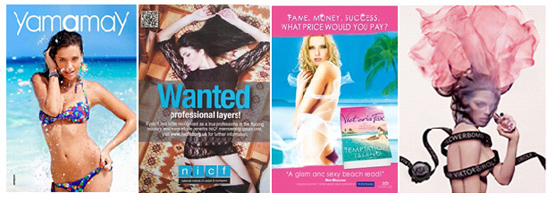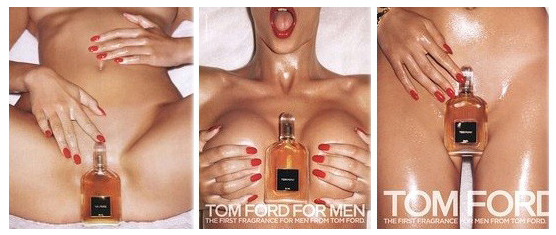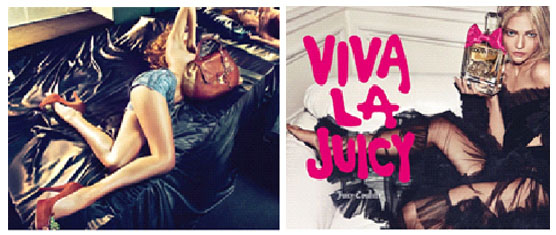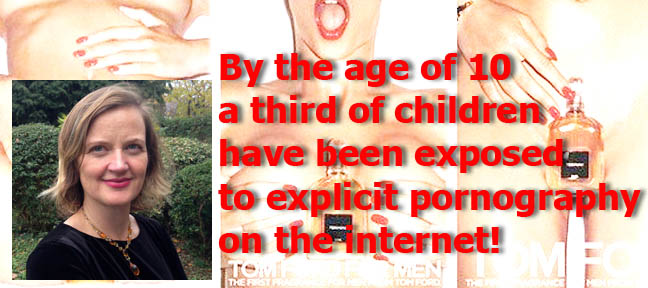Article in PDF (Download)
Sexualised imagery in advertising has gone too far by Elizabeth Willmott-Harrop (republished from a speech given by Elizabeth at the UK House of Commons in July 2012 – Link)
A UK report from 2012 Public Attitudes Towards Outdoor Advertising asked “how likely are you to be offended” by a range of advertisements, focusing on sexualised imagery.
Responses were graded from ‘very offensive’ to ‘not at all offensive’. The British Advertising Standards Authority (ASA) is required to prohibit advertisements causing “serious or widespread offence” (that criteria was not enough to ban a pornographic advertisement by Tom Ford in 2007), and concluded from the results that it is drawing the right line on sexual imagery in outdoor advertising.
Offensive vs appropriate
For me however, the crux of the report is not in the statistics, but in the use of the term offensive.
- In a world where new technologies have normalised the distribution of explicit personal photos;
- in a world where fly on the wall television hopes to facilitate live sex and is considered frivolous entertainment;
- in a world where sexual violence and drug addiction are glamorised to become mainstream song lyrics and images in coffee table reading;
- In a world where a child’s sexuality education is informed by depictions of sexual aggression and anal sex from pornography;
In such a world the limits of offense are high and wide, and using it as a standard opens a flood gate of unwelcome material into our material world.
Where is our sense not of offence, but of the appropriate?
I will describe 6 contemporary UK advertisements:
- A National Institute of Carpet and Floorlayers ad depicts a woman in a see through black lace dress, lying on the floor with the words “Wanted, professional layers!”;
- A Juicy Couture perfume ad shows an adolescent girl sitting on a bed, see through net skirt, off the shoulder top, legs apart;
- A Miss Sixty ad, model lying on her side, naked other than high shoes and tiny denim shorts, her legs apart and buttock raised;
- A Viktor and Rolf perfume ad with a naked model, gauze over her face, black ribbon around her breasts and body emulating bondage;
- Train stations displayed posters with a Barbie style topless woman, the strapline asks “Fame, money, power. What price would you pay?” The implication being prostitution.
- Easyjet magazine – in every seat pocket – has a swimsuit ad, the model with sexually suggestive expression and pose, tugging on her bikini bottoms.



The age of female models in many such advertisements is ambiguous and sits between adulthood and childhood, defined as under 18 by the UN Convention on the Rights of the Child.
Seeing is believing. We are far more accepting of the truth and integrity of an image than of discourse. What is considered inoffensive according to research can still show women and girls objectified and sexualised to the detriment of all.
Government
According to the European Parliament: “Advertising and marketing create culture rather than just reflect it, our concepts of gender being socially constructed and advertisements helping us construct them… gender stereotyping in advertising straitjackets women, men, girls and boys by restricting individuals to predetermined and artificial roles that are often degrading and humiliating.”
The United Nations Committee on the Elimination of Discrimination against Women which oversees the Convention on the Elimination of All Forms of Discrimination against Women (CEDAW) has registered its concern with stereotyped media portrayals of women in the UK.
The UK government responded saying it “does not seek to interfere in what a newspaper or magazine chooses to publish”. That response is not good enough.
Self-regulation by the advertising industry can give banned advertisements a barrage of further publicity after their initial airing and offers no significant financial or legal sanctions. The ads then remain on the internet, albeit not on the advertisers own website.
The ASA recently banned ads by American Apparel on the basis they were “exploitative and inappropriately sexualised young women”. When will we get to a point where such ads do not appear in the first place? That is effective regulation.
Human rights
The UN CEDAW committee also noted that the UK’s stereotyped media portrayals – of which sexualised imagery in advertising forms a part – “contribute to women’s disadvantaged position in a number of areas, including in the labour market”.
- Children account for 34% of hospital stays for eating disorders;
- By the age of 10, a third of children have been exposed to explicit pornography on the Internet;
- More than a quarter of people think a woman is partially or totally responsible for being raped if she was wearing sexy or revealing clothing;
- Britain has the world’s third-highest proportion of teenagers who are sexually active at an early age and the highest teenage birth and abortion rates in Western Europe;
- Depictions of violence against teenage girls on television have risen 400 per cent in 5 years;
- 280,000 teenage girls in the UK suffer from sexual assault believing it is an accepted part of a relationship or don’t know how to stop it;
- It will take 70 more years before we have an equal number of women MPs and directors in the FTSE 100;
This is our world. It is a world I will not accept and it is a world I will try and change, piece by piece.
Conclusion
The good news is that for every piece of the jigsaw there is something we can do. I quote again from the European Parliament: “responsible advertising can … be a strong tool in challenging and tackling stereotypes”.
We have to force the advertising industry to be what it prides itself on being – creative. Being creative in exploring equitable, respectful and positive ways to represent gender, identity and youth.
Self-regulation is failing to control the objectification of women, the denigration of childhood through sexualised images of young people, and the affront to gendered identities, which advertisements continue to portray.
© Elizabeth Willmott-Harrop



2 Replies to “Elizabeth Willmott-Harrop – Sexualised imagery in advertising”